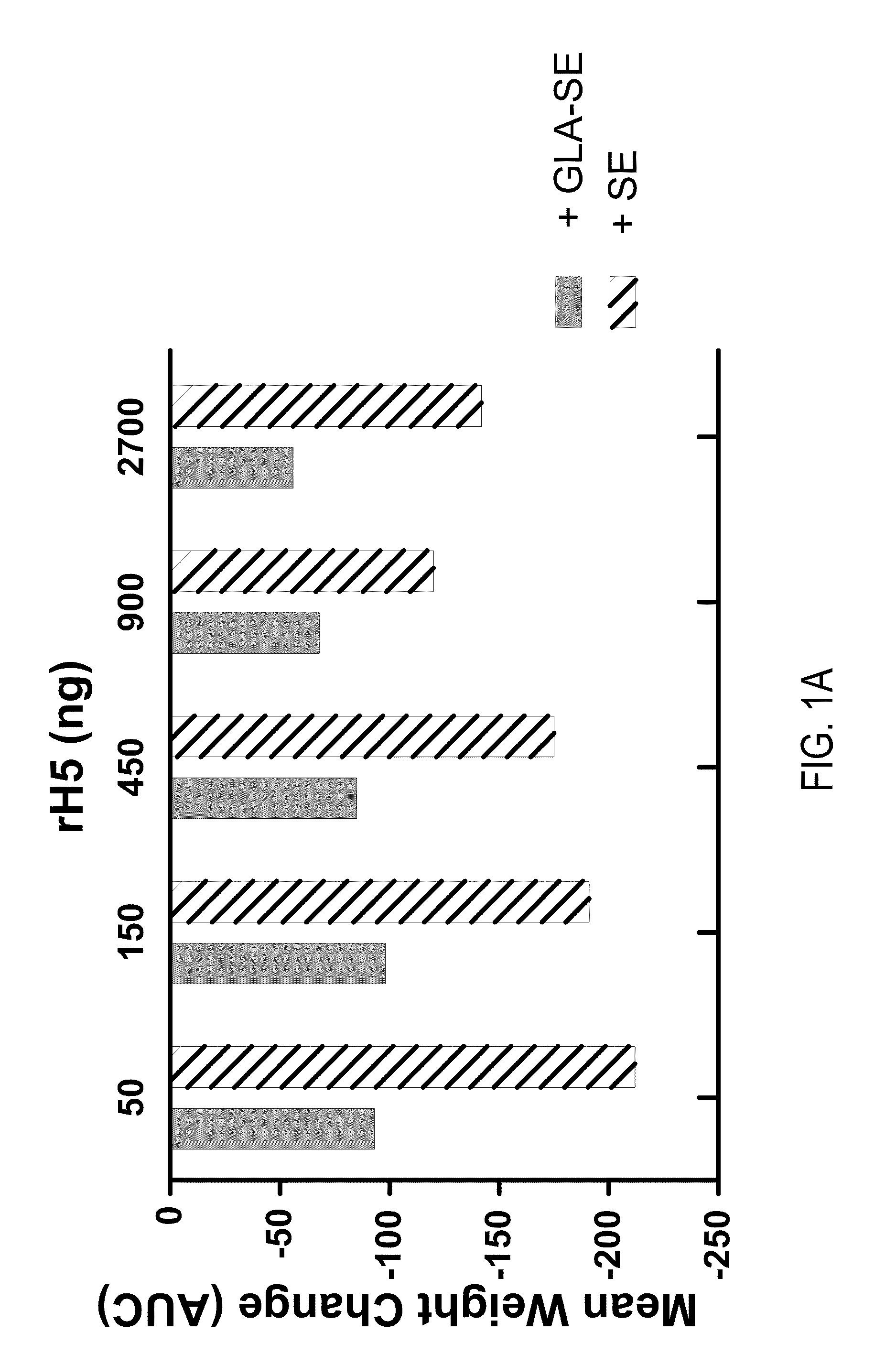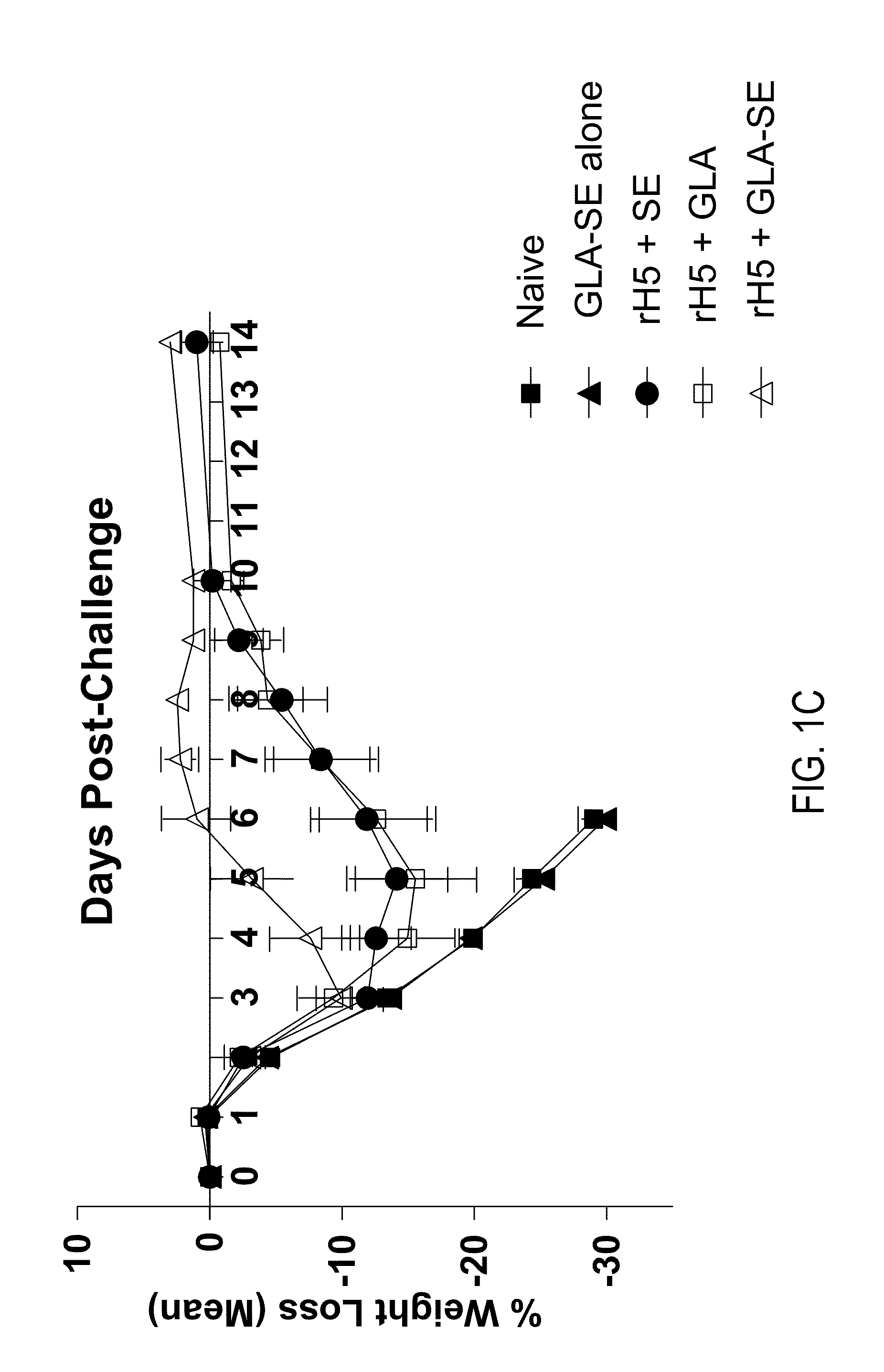Vaccines for Pandemic Influenza
a technology for pandemic influenza and preparation, applied in the direction of antibody medical ingredients, drug compositions, immunological disorders, etc., can solve the problems of rare but highly lethal, inability to effectively prevent and treat pandemic influenza, and inability to achieve the effect of reducing the risk of pandemic complications, and achieve the preferred level of glycosylation
- Summary
- Abstract
- Description
- Claims
- Application Information
AI Technical Summary
Benefits of technology
Problems solved by technology
Method used
Image
Examples
example 1
Efficacy of a Single Injection RH5 / GLA-SE Flu Vaccine in Mice
[0114]This example demonstrates that a single vaccination with recombinant influenza H5 (rH5) protein can effectively prime a protective anti-viral immune response in mice challenged with a high titer of H5N1 virus. Balb / c mice (5 / group) were injected intramuscularly (IM) once with increasing amounts (0, 50, 150, 450, 900, or 2700 ng) of rH5 protein (derived from H5N1 Viet Nam 1203; available from Protein Sciences, Meriden, Conn.) alone or rH5 protein formulated with GLA-SE adjuvant (20 μg of GLA in 2% SE). Mice were challenged 14 days later by intranasal administration of H5N1 Viet Nam 1203 (1000×LD50). Mice were monitored daily for weight loss and euthanized if loss of weight was greater than 20-30%. Vaccination with rH5 protein alone did not provide protective immunity as all animals injected with rH5 in the absence of adjuvant either died spontaneously following viral challenge (18 / 25 animals) or displayed significant ...
example 2
RH5 / GLA-SE Flu Vaccine Confers Heterolgous Immunity in Mice When Administered as a Single Injection
[0119]In this example, the protective efficacy of recombinant vaccine formulated with GLA adjuvant against heterologous viral challenge was demonstrated. For these experiments, mice were immunized with a single injection of the rH5 protein isolated from H5N1 Indonesia (clade 2.3), followed by challenge with the H5N1VN virus, as described above. As a positive control, mice were vaccinated with the homologous rH5 protein from H5N1Vietnam, while as a negative control, mice were vaccinated with an unrelated HSV-2 viral protein (rG013). As shown in Table 1, mice vaccinated with the HSV-2 protein all died, irrespective of the protein-adjuvant formulation. All mice vaccinated with 50 ng of homologous rH5VN protein alone died, while all mice vaccinated with rH5VN formulated with GLA-SE adjuvant survived, consistent with previous findings. Importantly, all mice receiving either 50 ng or 200 ng ...
example 3
GLA-SE Accelerates Establishment of Antigen-Specific Immunity in Mice
[0121]This example demonstrates the temporal requirements for establishing immunity in the mouse protection model by challenging mice with influenza virus at successive days following immunization. Mice were vaccinated with a single injection of a low dose of rH5 protein formulated in SE alone or GLA-SE adjuvant, as previously described. As controls, mice were vaccinated with rH5 protein or GLA-SE alone. Mice were challenged at various days (0, 2, 4, 6, 8, 10, or 12 days) following vaccination and percent survival was determined 14 days later. As shown in FIG. 3A, rH5 protein formulated with GLA adjuvant established protective immunity within 4-6 days post-vaccination. As expected, this effect was dependent upon both recombinant protein and GLA-SE, as mice receiving vaccines lacking either of these components all died. Mice receiving rH5 formulated in SE alone also demonstrated protection from viral challenge, alth...
PUM
| Property | Measurement | Unit |
|---|---|---|
| Fraction | aaaaa | aaaaa |
| Mass | aaaaa | aaaaa |
| Mass | aaaaa | aaaaa |
Abstract
Description
Claims
Application Information
 Login to View More
Login to View More - R&D
- Intellectual Property
- Life Sciences
- Materials
- Tech Scout
- Unparalleled Data Quality
- Higher Quality Content
- 60% Fewer Hallucinations
Browse by: Latest US Patents, China's latest patents, Technical Efficacy Thesaurus, Application Domain, Technology Topic, Popular Technical Reports.
© 2025 PatSnap. All rights reserved.Legal|Privacy policy|Modern Slavery Act Transparency Statement|Sitemap|About US| Contact US: help@patsnap.com



